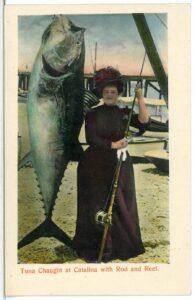Fishing has remained good for striped bass. The weather has been great, and with no serious cold fronts coming through, water temperatures haven’t plummeted. Still, the bass have begun to move south as evidenced by good catches being reported along the south shore of Long Island and the Jersey Shore.
With the migration underway, what we’re seeing are bass from north of us coming through. As usual this season, the ocean side has been far more productive than the bay. Bluefish have pretty much gone south.
Tuna fishing in the bay has been hit or miss, certainly not the white-hot fishing for giants that we’ve come to expect during the fall. Commercial tuna fishing has taken some interesting twists, which could have a dramatic effect on the shrinking numbers of commercial tuna fishermen here.

Two factors in particular will change the global market as well as the local landscape. One is a change in the marketability of Prince Edward Island tuna. Bluefin tuna feast on herring and mackerel. A few years back, while looking at dwindling stocks, Fisheries and Oceans Canada banned commercial bait fishing for herring in the Gulf of St. Lawrence and for mackerel in the waters of the Canadian Atlantic. Both species have rebounded remarkably well. Because of that, tuna caught off Prince Edward Island have had much higher fat content, which leads to much better prices in global markets. Roughly 1,500 tuna come out of the Prince Edward Island area each season.
The other factor is the recovery of Pacific bluefin tuna. Once on the verge of a complete collapse, that fishery has roared back, thanks in part to effective conservation efforts. Consequently, commercial Pacific bluefin tuna vessels in the U.S. will be allowed to catch 80 percent more fish in the upcoming 2025–2026 season.
The Inter-American Tropical Tuna Commission approved the increased catch limits during a meeting in Panama in early September. This decision comes three months after an international scientific committee for tuna in the North Pacific Ocean, following an encouraging stock assessment, found the species’ population to be completely rebuilt a full decade ahead of schedule.
In 2022, U.S. commercial tuna fishermen harvested 368 metric tons, or a little more than 800,000 pounds, of Pacific bluefin tuna. They earned roughly $2.2 million for their catch, according to a NOAA Fisheries report posted Oct. 9. The numbers sound big, but when you do the math that works out to $2.50 a pound. The two-year catch limit for 2025–26 is increasing to 1,822 metric tons from 1,017 in 2023–24. So, the U.S. fleet can bring substantially more Pacific bluefin tuna to seafood markets next season. This would be a welcome change for Pacific Ocean captains, crews, and seafood distributors after more than a decade of living with severe limits in the Pacific fishery.
Back in our neck of the woods, the tuna fishermen I talk to tell me the market is soft: prices are low — if you can even sell the fish. A consensus is emerging that our local fishery needs to adapt and shift to a more domestic market rather than exclusively exporting tuna, as has been the case.
There is even some talk in Gloucester of tuna fishermen creating a cooperative processing facility where their fish could be vacuum packed and frozen and then sold domestically to restaurants and retail markets and shipped anywhere in the country. Tuna are highly perishable fish, and fresh, unfrozen tuna makes up only about a quarter of the global market, so the Gloucester plan could be a viable one. It’s something to watch with interest.



